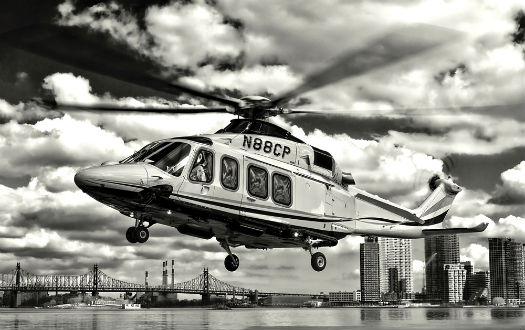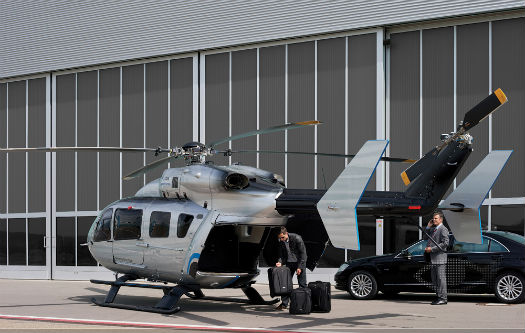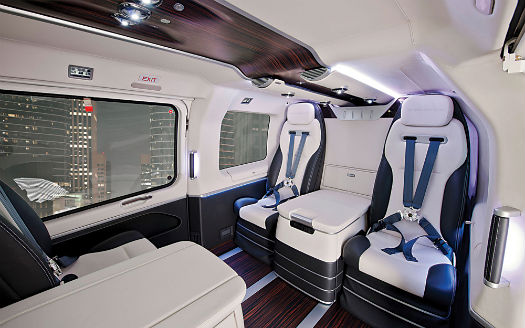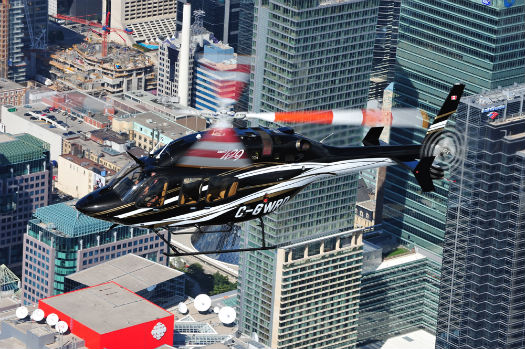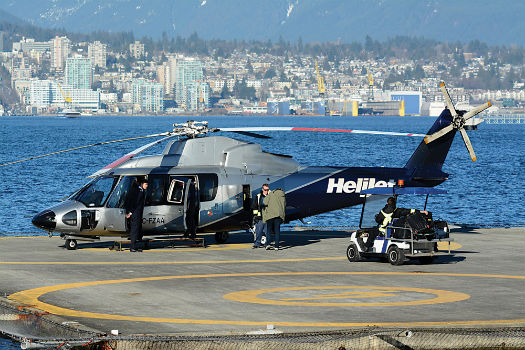According to Patricia Wagner, manager of Atlantic Aviation’s East 34th Street
heliport in New York City, several corporate operators have opted for the
AgustaWestland AW139. Joe Cortez Photo
The helicopter is one of the most efficient methods of point-to-point business travel over short and medium distances. Since the late 1940s, a select group of businesses and executives have utilized helicopters to enhance productivity.
Business aviation is often touted as a mobility tool, an economic enabler and a game changer. That was the conclusion of a report published in 2009 by NEXA Advisors. The National Business Aviation Association (NBAA) and General Aviation Manufacturers Association (GAMA) sponsored the report to examine the impact of business aircraft on operations and financial performance, leading to higher shareholder value.
NEXA concluded that, “business aircraft can make a substantial difference in how a company performs its mission, in many cases making a direct contribution to the drivers of shareholder and enterprise value. Increased mobility is at the core of these gains–satisfying management’s need for greater organizational agility, knowledge integration and transaction speed.”
NEXA’s report primarily focused on utilizing fixed-wing aircraft for airport-to-airport travel, but the mobility and productivity benefits of a helicopter can also contribute to the success of a business. While many factors go into determining whether a business aircraft is the optimum tool for a specific mission, one of the most important benefits is derived from the “door-to-door” time savings of flying directly from point of origin to destination. This leverages a company’s human capital and increases overall organizational efficiency, said NEXA.
Airbus Helicopters estimates that an average of 67 new turbine corporate helicopters
are sold in the U.S. and Canada each year, ranging from Robinson R66s to larger
twin-engine IFR cabin class models. Airbus Helicopters USA Photo
Defining the Market
The business helicopter market varies in size, depending on how you count the helicopters that are used for both business and personal use.
“We estimate that one quarter of the 24,000 Western-manufactured turbine powered helicopters in service in the world today [with five seats or more] is flown for business purposes,” said Chuck Evans, director of marketing for Bell Helicopter Textron. “That’s about 5,500 turbine-powered aircraft, of which 70 per cent are single-engine and 30 per cent twin-engine. About 55 per cent of this fleet is concentrated in North America and Europe (3,025 aircraft), 25 per cent in Latin America (1,375 aircraft) and 20 per cent (1,100) in the rest of the world,” he continued.
Sikorsky Global Helicopters estimates the worldwide corporate fleet (business/executive corporate) at 3,460 turbine helicopters, of which 550 are FAR Part 29 certified helicopters in the intermediate to heavy category (with a gross weight of more than 7,000 pounds), according to Jeanette Eaton, director for Sikorsky Global’s commercial systems and services. “The North American fleet is comprised of 950 single and twin-engine turbine helicopters, of which 140 are in the intermediate to heavy class,” she added.
According to AgustaWestland, the recovery in the corporate helicopter market from the 2008-2009 financial crisis has accelerated since 2010-2011. Airbus Helicopters estimates that an average of 67 new turbine corporate helicopters are sold in the U.S. and Canada each year, ranging from Robinson R66s to larger twin-engine IFR cabin class models.
“After passenger capacity, the most important attributes of a true corporate helicopter are the quality of the ride, speed and internal noise,” noted Kristopher Desoto, VIP and corporate segment specialist for Airbus Helicopters, Inc.
“Business helicopter sales, like corporate jet sales, track corporate profits. However, helicopter demand can also be reinvigorated with the development of new generation aircraft and the introduction of new integrated digital avionics and safety technology into existing models,” explained Bell’s Evans. In this regard, Bell has high expectations of winning corporate sales for the wheel-equipped Model 429WLG, along with the new 505 Jet Ranger X and 525, as does AgustaWestland for its new AW109 Trekker and AW169; Airbus with the updated EC130/EC145 T2 versions and new EC175 and X4; and Sikorsky with the S-76D.
After passenger capacity, the most important attributes of a corporate helicopter are
the quality of the ride, speed and internal noise. Airbus Helicopters USA Photo
Canadian Market
There were about 730 private and business-owned helicopters flying in Canada as of Aug. 1, 2014, according to the Canadian civil aircraft register (excluding amateur-built helicopters, new production models, military trainers and lessor inventory). About 57 per cent of the private and corporate Canadian fleet is piston-powered, 39 per cent single-turbine and four per cent twin-turbine.
AIC Global Holdings Inc. flies four executive helicopters (Bell 206, Sikorsky S-76C+, AgustaWestland AW139 and Sikorsky S-92A) that pick up executives at the heliport at its head office in Burlington, Ont., and fly them to meetings in downtown Toronto (avoiding the congested QEW highway) and the United States.
AIC’s S-92A is one of only two in corporate use in North America, although the aircraft is popular with foreign heads of state and was recently selected as the basis for the next U.S. Presidential helicopter.
Helijet International is the largest operator of executive Sikorsky S-76s in Canada, but there is a twist. Most of Helijet’s business passengers fly on scheduled S-76 flights between Vancouver and Victoria harbour in B.C., and most of its leisure passengers fly on S-76s chartered to fly guests to high-end salmon fishing resorts on the northern B.C. coast and in Haida Gwaii (Queen Charlotte Islands).
London Air Services operates three executive AgustaWestland AW139s from Vancouver, with about 90 per cent of their work flying wealthy guests to the exclusive Sonora Resort, located 50 minutes to the north by air and operated by a sister company.
London Air Services of Vancouver operates three executive AgustaWestland
AW139s, which mostly fly guests to the exclusive Sonora Resort. Mike Reyno Photo
Corporate Utility
Only a handful of Canada’s largest corporations own helicopters, and most of these are used for utility work. Ontario Hydro Networks of Toronto is the largest corporate fleet operator with eight single-engine helicopters (one Bell Long Ranger, seven Airbus AS350B-2/B-3s) used to construct, maintain and repair electric transmission lines, with a new light twin on order.
Other utilities employing helicopters include Enbridge Pipelines Inc. (Airbus EC120B), Churchill Falls (Labrador) Corp. (one Bell 206B, one 407 and one 205A-1) and TransCanada Pipelines Ltd., which flies three helicopters in Canada (two Bell 206B and a 206L-4) and four AgustaWestland AW119 Koalas offshore in the Gulf of Mexico.
J.D. Irving Ltd. subsidiary Forest Patrol of New Brunswick flies two Bell 407s primarily for forest management, and they fly company executives on occasion.
Owner/Pilots
The private Canadian piston helicopter fleet includes 74 Robinson R22s and 239 R44s. One of the best indications of the healthy state of the private helicopter market is the registration of 30 private Robinson R66s in the year since Transport Canada certified this five-seat turbine model in mid-2013.
The private turbine market also includes older Bell Jet Rangers and Long Rangers and Airbus AStars and current production Bell 407s, Airbus AS350B3e, EC120B and EC130 helicopters, as well as a handful of Enstrom 480s and MD variants with NOTAR (no tail rotor). The top end of the Canadian single-turbine market today includes the AW119 and the Eurocopter EC130 T2.
One unique feature is that Quebec is home to Canada’s largest concentration of personal helicopters–piston and turbine. A lot of credit for market development in the French-speaking province must be given to local Robinson dealers such as Marcel Boutin at HelicoStore, who has delivered more than 100 Robinson models among the 148 private R22s, R44s and turbine R66s flying in Quebec today. Borrowing a page from Quebec’s many snowmobile clubs, local Robinson owners/pilots regularly participate in fly-ins and air tours of up to 34 aircraft, which have expanded the social aspects of helicopter ownership.
In total, Canada’s twin-turbine corporate fleet comprises about 30 helicopters owned by individuals and companies that value a larger aircraft with enhanced safety and comfort.
Widely dispersed across the country, the fleet includes one Bell 222B (Cardinal Couriers), an Airbus AS355, three Bell 427s (Kruger Inc., Dunkley Lumber Ltd., Coordinates Capital), two Sikorsky S-76s, two Bell 430s, four Bell 429s, and about nine AgustaWestland AW109s, with approximately half of this fleet under management contract and available for charter.
The Bell 429 is proving to be popular for corporate and private use. This 429 is
owned and flown by Bob Dengler in Toronto, Ont. Mike Reyno Photo
A Place to Land
Canada is home to 367 licensed heliports, of which about 31 are listed as public use facilities, according to the Canada Flight Supplement. Arguably, the best-equipped public use heliports in Canada are located in Vancouver, Victoria and Whistler, B.C., where private and commercial stakeholders banded together in the 1980s to obtain municipal approvals and Transport Canada funding. These heliports have sustained scheduled service and supported emergency services, but the amount of corporate helicopter use has surprisingly declined.
“The big forestry companies that used to operate a lot of corporate helicopters started to cut back their fleets when they merged and most later closed their flight departments,” said Danny Sitnam, president of Helijet, which also manages the Vancouver and Victoria harbour heliports. “The decline is really a reflection of the decline of the forest industry in the province. Those executives that still need to travel now use a chartered aircraft.”
Downtown Calgary has long had a public-use heliport adjacent to the Bow River, but Edmonton-based businesses and the Edmonton Police Department lost a downtown landing zone when the city closed the Edmonton Municipal Airport on Nov. 30, 2013.
Toronto helicopter users have benefitted from the revitalization of the Billy Bishop Toronto City Airport, which will soon have 24-hour access via a pedestrian tunnel to augment the ferry service.
The expansion of dedicated helicopter emergency medical services in Alberta, B.C., Nova Scotia and Ontario in the 1980s and 90s led to the parallel construction of new hospital heliports; however, most of these are restricted to emergency use.
There are only 31 public use heliports in Canada. The best-equipped are located
in Vancouver and Victoria, B.C. Jeff Wilson Photo
U.S. Perspective
Spend a few hours at the edge of any one of New York City’s three downtown heliports and you will see how major Fortune 100 corporations utilize twin-engine cabin class IFR helicopters to maximize the productivity of their executives in the Northeastern United States.
On any given business day, twin-engine AgustaWestland, Airbus, Bell, MD and Sikorsky helicopters zip in and out of Manhattan air space.
“The biggest market change since the financial crisis of 2008-2009 is the number of new generation helicopters we see,” said Patricia Wagner, manager of Atlantic Aviation’s East 34th Street heliport. “Many corporate operators continue to upgrade their helicopter aircraft to include the AgustaWestland 139 with increased range and passenger capacity, and others added new light twin turbine models.”
There are less than 50 cabin class helicopters in the United States that fly pure business missions compared to the hundreds of business jets operated by corporate flight departments, noted Airbus Helicopters’ Kristopher Desoto.
“More than 75 per cent of these helicopters are based in the U.S. Northeast, where a combination of factors support intense helicopter use. These factors include a major world financial centre on a congested island (Manhattan), a large concentration of corporate headquarters and high net worth individuals, well-established downtown heliports, and five local airports that cater to corporate jet service.”
All of these helicopters are equipped with wheels, Desoto continued, “so they can land at an airport and pull up next to a $60-million business jet or the front door of an FBO (fixed-base operator). The wheels have a practical purpose because no aircraft or FBO owner wants to see a skid-equipped helicopter blowing ramp debris while it hover-taxis near an expensive business jet.”
The Northeast also has a large concentration of leisure travellers who charter VIP helicopters for personal use to reach their exclusive golf club or vacation home in the Hamptons or Martha’s Vineyard.
The charter market in the New York area is well served by several VIP companies operating twin-engine aircraft, such as the Airbus AS355 TwinStar and AS365N Dauphin, Bell 430 and Sikorsky S-76.
For example, Associated Aircraft Group, a subsidiary of Sikorsky, operates a fleet of nine S-76s from Dutchess County Airport. The company also has a fractional ownership program, Sikorsky Shares, and the AAG Excalibur Card with prepaid flight units. HeliFlite flies a fleet of Bell 430s and S-76s based at Newark Liberty International Airport (EWR), and both Liberty Helicopters and Analar Corporation fly twin-engine AS365N Dauphins as well as other helicopter models.
Airbus Helicopters Canada delivered this AS350 B2 to business owner and aviation
enthusiast Harvey Stever in August. The private-use helicopter will be based in
Quebec City, Que. Vitek Zawada Photo
The Entrepreneurs
Another 450 private helicopters with corporate or VIP interiors have been delivered in the U.S. for a combination of business and personal use, according to Desoto. “These tend to be smaller single- and twin-engine helicopters than those used by the large corporations,” he said.
One example is David MacNeil, owner of MacNeil Automotive Products Ltd. in Bolingbrook, Ill, who took delivery of a customized Airbus AS350 B3e for use in business travels. The MacNeil aircraft is the first equipped with a Garmin G500H “glass cockpit” multifunction electronic flight display system installed under an FAA Supplemental Type Certificate (STC).
Another example is is billionaire businessman Michael Bloomberg, who flies a personal AgustaWestland AW109. While mayor of New York City, he was a strong advocate for keeping heliports accessible in Manhattan.
Other personal helicopters ranging from EC120s to S-76Ds have been purchased by ultra high net worth individuals (i.e., Microsoft co-founder Paul Allen) for use aboard 100- to 500-foot super yachts based throughout the world.
One of the major challenges to growing business helicopter use is having public use heliports in downtown locations to stimulate business mobility and productivity. Baltimore is one of the only major cities in the U.S. to gain a new public use downtown heliport in the 21st century.
GrandView Aviation (previously Baltimore Helicopter Services) developed the Pier 7 heliport as a downtown FBO with fuel and a base for its Bell 407 and Bell 430 that fly Part 91 (not-for-hire) flights for its owners and Part 135 charters.
“Half our flying is on behalf of the six partners in our business and the balance is charters, with most flights originating or ending at our heliport,” said Jessie Bowling, director of sales and marketing at GrandView. “Our greatest source for new charter business is customer referrals, clients from our city centre marina business and news stories about our company.”
GrandView is also seeing an increase in charter requests to fly to Washington, DC, since the Transportation Security Administration approved its heliport as a gateway, and the company qualified to fly to Reagan National Airport (DCA) under the DCA Access Standard Security Program (DASSP). “These flights are popular with clients who want to be in Washington at a specific time and don’t want to be delayed by traffic, and customers know one seat must occupied by an armed air marshal,” said Bowling.
The opening of the Chicago Vertiport on a 10-acre site in the city’s Medical District later this year is expected to stimulate many new corporate helicopter sales opportunities in the area. Downtown Chicago lost its only place to land helicopters 11 years ago, when Meigs Field closed in 2003. The new Chicago Vertiport will feature 1,000 square feet of office space and a 30,000-square-foot hangar.
